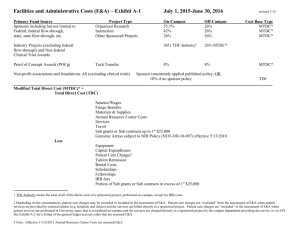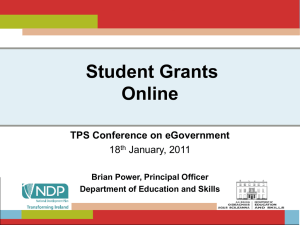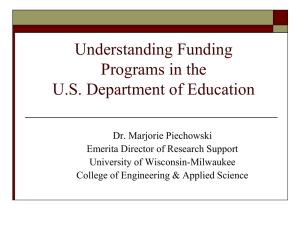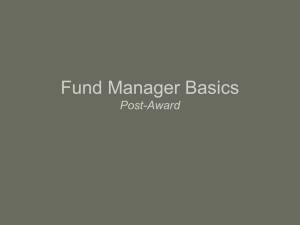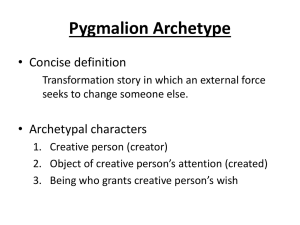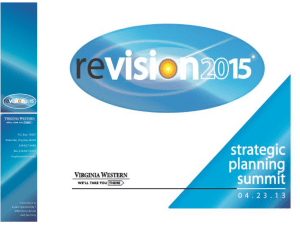Grant agreement
advertisement
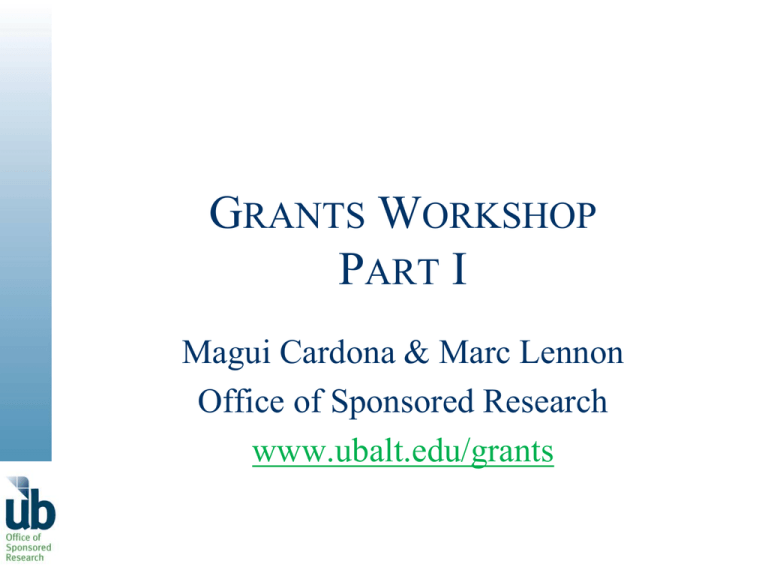
GRANTS WORKSHOP PART I Magui Cardona & Marc Lennon Office of Sponsored Research www.ubalt.edu/grants Workshop Outline • Searching for funding opportunities • Reading the RFP & interpreting agency guidelines • Proposal development • Budget development • Institutional routing & approval policies • Proposal submission • Peer-review & resubmission Why get grants? • Enables your research project • Allows you to maintain a reduced teaching load through buyouts • May provide summer salary, student assistants & travel funds for research work • Ultimately leads to more publications, increasing your tenure potential Grant Life Cycle Types of Funding Agreements • Procurement contract – The principal purpose is the acquisition of goods & services for the direct benefit of the government • Grant agreement – The principal purpose is the transfer of funds to recipients to carry out a public purpose (research) • Cooperative agreement – Like a grant, but with substantial government involvement SEARCHING FOR FUNDING OPPORTUNITIES How to identify a funding agency? • Search databases or agency websites (see supplemental materials for a complete list) • Search the literature in your field for funding sources acknowledged • Identify the agency’s mission – Review other proposals funded by them – Ask yourself, “Do my research interests fit with their mission?” Primary Grant Search Sources • Grants.gov • IRIS (Illinois Researcher Information Service) • Maryland Governor’s Grants Office Grants.gov • Central web portal for all Federal government-wide grant opportunities • Registration is not needed to search for grants on Grants.gov • Multiple Search Options are available • Tips for managing and understanding search results Grants.gov Grants.gov Search Options • • • • • • Basic Search Browse by category Browse by agency Advanced Search Email/RSS Subscription Browse New Opportunities This Week Grants.gov: Basic Search • A Keyword search alone usually results in a large list of unrelated funding opportunities • Basic Search is useful if you have a specific : – Funding Opportunity Announcement (FOA) # and/or – Catalogue of Federal Domestic Assistance (CFDA) # Grants.gov: Browse by Category or Agency • Lists all available funding opportunities for certain research categories and funding agencies • Usefulness varies by category and agency – Results for popular categories and larger agencies can be voluminous Grants.gov: Advanced Search • Combines functions of other Grants.gov search options • Additional Advanced Search criteria also include: – Closed & archived funding opportunities – Open Date – Eligibility of Institution Grants.gov: Email/RSS Subscriptions • Receive notifications of new grant opportunity postings and updates via email or RSS feed. Options include: – – – – Grants.gov updates All grant notices Grant notices based on your selected criteria Grant notices based on FOA # Grants.gov: New Opportunities This Week Grants.gov: Sorting Search Results • Open date (default) • Close date • Relevance (only for keyword searches) Grants.gov: Understanding the Opportunity Synopsis • • • • • • • • • Change Notification Email FOA# Closing Date Award Ceiling/Floor Cost Sharing or Matching Requirement Eligibility Name of Funding Agency Description Link to Full Announcement Illinois Researcher Information Service (IRIS) • IRIS Database • IRIS Alert Service • http://www.library.illinois.edu/iris/ IRIS Database • Over 9,000 active funding opportunities • Federal, foundation, and corporate sponsors • Opportunities in sciences, social sciences, arts & humanities • Student fellowships & scholarships • Multiple search criteria IRIS: Searching the Database • Search fields include: – – – – – Sponsor Title Deadline Abstract Keywords • Qualifiers include: – – – – – Activities Supported Citizenship Sponsor Type Academic Qualifications Restrictions • Start broadly and use search options to narrow results as needed • Use quotation marks around search phrases • Keyword Thesaurus is available IRIS Alert Service • Email/web-based service that provides regular search results from the IRIS database according to a user profile • Individual profiles allow customized settings that include: – Search frequency – Delivery method (e-mail or Web) – Research interest related keywords IRIS: Tips for Selecting Keywords • • • • Keyword Thesaurus is arranged hierarchically Starts broadly and becomes more specific Indentation indicates specificity More-specific keywords cancel out lessspecific keywords Maryland Governor’s Grants Office • Website lists all open grants available from the State of Maryland • http://grants.maryland.gov/Pages/find.aspx READING THE RFP & INTERPRETING AGENCY GUIDELINES The Typical Request for Proposals • Summary of Program Requirements • Proposal Preparation and Submission Instructions • Proposal Review Information & Criteria • Award Administration Information Summary of Program Requirements • Program description – supports agency goals • Contact information for questions • Catalog of Federal Domestic Assistance (CFDA) Number • Award information – Anticipated type of award – grant, contract, etc. – Funding availability – indicates how competitive • Eligibility Requirements – Individual & institutional Proposal Preparation and Submission Instructions • Are letters of intent required or encouraged? • Are preliminary proposals allowed? • What sections should the proposal include? – READ instructions carefully! • Budgetary information – Is cost sharing required? – Are there any budget limitations, floor or ceiling? • Due Dates – usually 5:00 pm local time Proposal Review Information & Criteria – NSF • Intellectual Merit – Relevance to the discipline • Broader Impacts – Relevance to other disciplines and society at large • Integration of Research & Education • Integrating Diversity into NSF Programs, Projects & Activities Proposal Review Information & Criteria – NEH • Intellectual significance of the project • Pertinence of the research question and appropriateness of methods • Qualification of PI • Soundness of the dissemination and access plans • Potential for success Proposal Review Information & Criteria – NIH • • • • • Significance Investigator(s) Innovation Approach Environment Award Administration Information • Awards terms & conditions – Awards are made to the institution, not the PI – Substantial changes to the SOW or budget require prior approval • Reporting Requirements – Technical reports – typically once a year by PI – Financial reports – quarterly by grant accountant PROPOSAL DEVELOPMENT Writing your Proposal • Write clearly and concisely – Use short, declarative sentences – Avoid complicated words, jargon & abbreviations • Write for an informed generalist, not a specialist in your field • Do not leave anything to interpretation – Describe how you will address any weaknesses • If reviewers don’t understand your proposal, they are unlikely to recommend it for funding – It is both about substance & marketing Typical Proposal Sections • • • • • • • • • Abstract/Summary Objectives/Specific Aims Background/Literature Review Significance Research Design/Methodology Preliminary Results, if available Qualifications of the PI Institutional Resources Budget Abstract/Summary • No more than one page, sometimes less – Needs to be informative and brief – Most important marketing tool in your proposal • • • • • Describe the problem or question Propose a solution List specific activities you will undertake Describe the expected outcomes Explain the significance of the work Objectives/Specific Aims • Briefly describe your long-term research agenda, beyond this proposal • Enumerate the specific goals for this proposal • Each goal should be tied to specific activities – Are they sequential or parallel? • Describe the expected outcomes of each activity Background/Literature Review • What is known about your research topic? – Ensure you are aware of the most current literature on the subject • What is the gap your research proposal will help fill? Significance • Why is your work important? – Intellectual Merit or Relevance • What will be the return on investment if the proposal is funded? – Broader Impacts Research Design/Methodology • Describe in detail your research design & methodology – – – – What will you do? How will you do it? What could go wrong? How will you deal with it? What results do you expect? What will they mean? • Include a time table and justify your approach Preliminary Results • Only include if you have unpublished data of your own – Describe the relevance of the data to your research objectives – Interpret the results for the reviewers • Preliminary results aide in showing likelihood of success PI Qualifications • Highlight special qualifications or expertise • Explain how you will deal with any existing knowledge gaps – Collaborators – Additional training • Include references to relevant publications Institutional Resources • Need to be specific, but only list relevant resources • Talk about institutional environment for research • Include letters of collaboration, if applicable BUDGET DEVELOPMENT Grant Budgeting Overview • Cost Principles inform budget decisions • The elements of a budget • Budgeting Tips OMB Circular A-21 • Part of Federal Administrative Regulations • Establishes cost standards for all sponsored agreements awarded to educational institutions A-21 Cost Standards • • • • Reasonable Allocable Consistently treated Allowable Cost Standards: Reasonable • Would a prudent person incur the cost based on the nature of the goods/service and the dollar amount? • Cost must be necessary for the performance of the project • Cost must be consistent with University policies Source: OMB Circular A-21, Section C.3.Reasonable costs. Cost Standards: Allocable • Costs charged to a sponsored project must benefit that project • Costs can be charged to multiple projects based on proportional benefit • Costs may not be shifted to other sponsored agreements for convenience Source: OMB Circular A-21, Section C.4.Allocable costs. Cost Standards: Consistent Treatment • Consistency in estimating, accumulating, and reporting costs • Consistency in allocating costs for the same purpose Source: OMB Circular A-21, Section C.2.Factors affecting allowability of costs. Cost Standards: Allowable • Costs must be reasonable, allocable, and treated consistently • Costs must conform to the sponsored agreement Source: OMB Circular A-21, Section C.2.Factors affecting allowability of costs. Elements of a Budget • Direct Costs – – – – – – Personnel Travel Equipment Consultants Subagreements Supplies and other direct costs • Indirect Costs aka Facilities & Administrative (F&A) Costs Direct Costs vs. Indirect Costs • Direct Costs – costs that are specifically identified with a particular project or that can be assigned to a project relatively easily and with a high degree of accuracy (i.e. salary) • Indirect Costs (F&A Costs) – costs that are incurred for common institutional objectives and that cannot be readily and specifically identified with a particular project (i.e. electricity usage) Source: OMB Circular A-21, Sections D.1. and E.1 Personnel • Personnel Types – – – – Faculty Regular Staff Contingent Employees Student Assistants • Fringe Benefits Personnel - Faculty • Course Buyouts – Grant funding can be used to “buy out” teaching responsibilities for a course (with Dean and Chair approval) – 10% of effort is budgeted – Fringe Benefits calculated at the Faculty rate • Overload Pay – Up to 20% of effort allowed in addition to regular faculty responsibilities – Fringe Benefits are calculated at the Contractual Employee rate – Generally not permitted on Federal grants • Summer Salary – Maximum of two months at 120% of base pay permitted – Fringe Benefits are calculated at the Contractual Employee rate – Generally permitted for Federal grants only to the 100% level UB Policy on Grant Sponsored Research: http://www.ubalt.edu/policies/index.cfm?page=84 Personnel – Staff • Regular Staff – Time calculated as a percentage of effort – Administrative staff cannot be charged to a sponsored project unless duties are project specific Personnel - Contingent (Contractual) Employees • Type I – Agreement for less than 6 months • Type II – Agreement for 6 months but no more than 12 consecutive months – Some limited benefits Personnel – Student Assistants • Graduate Assistants – – – – Yearly stipend (rate set by Dean’s Office) Tuition reimbursement budgeted to grant (in-state rate) No fringe benefits budgeted Research-related work must make up a minimum of 70% of duties (No more than 30% clerical) • Student assistants – Contingent I contract – Typical rate between $10-$15 per hour – Fringe benefits must also be budgeted Personnel – Fringe Benefits • Calculated as a percentage of salary charged to grant • Rates – – – – – Faculty 27% Managerial (Exempt Staff) 30% Administrative/Support Staff (Non-exempt) 44% Part-Time Employees (Contingent) 8% % of Full-Time/Visiting Specialist 27% Travel • Calculate based on # of people and # of days • Items to consider – Airfare • Fly America Act – Ground transportation • Current mileage rate is $0.50 per mile (State Rate) • Taxi, train, bus, light rail, etc. – Hotel accommodations • Maximum Federal rates, http://www.gsa.gov/portal/category/21287 – Meal per diem • National: UB Policy is to use MD rates, http://www.ubalt.edu/template.cfm?page=1131 • International: Federal Rates, http://www.gsa.gov/portal/category/21287 – Registration fees Equipment • UB’s threshold for property to be considered equipment is $500 • Items under $500 should be budgeted as project supplies Subagreements vs. Vendors • Subagreement – Partner provides intellectual merit – Partner participates in programmatic decision making for a project – Agreement negotiated by UB Office of Sponsored Research – Portions of individual subcontracts in excess of $25,000 are excluded from F&A cost calculations on projects using an MTDC base (entire agreement excluded from Federal rate) • Vendor – Primarily for goods and services – Intellectual merit is not contributed – Contract negotiated by UB Office of Procurement and Materials Management Consultants • Provide specialized expertise necessary to accomplish project goals • Do not provide intellectual merit to the project • Type of vendor • Typically an individual • Typically costs are based on an hourly or daily rate, plus expenses Supplies and Other Direct Costs • Must be used specifically for the performance of the specific sponsored project • Items to consider – – – – – – – Project related office supplies Telephone Publication and Printing costs Computer Services Software Space rental (for off-campus projects only) Other Miscellaneous project related costs Indirect Cost Rates – FY11 Sponsored Research Programs Federal Grants/Contracts State Government – General State Government - Schaefer Center Local Government Private/Corporate Non-Profit/Foundations On-Campus 43% S&W 15% MTDC 25% S&W 15% MTDC 50% MTDC 15% MTDC Off-Campus 25% S&W 15% MTDC 15% MTDC 15% MTDC 25% MTDC 15% MTDC S & W = Salaries & Wages (does not include fringe benefits) MTDC = Modified Total Direct Costs Budgeting Tips • Build your budget in a Spreadsheet – Templates are available • Utilize formulas for calculations – AutoSum • =SUM(A1+B1…) • =SUM(A1:A20) – Rounding • =ROUND(A1*B1,0) INSTITUTIONAL ROUTING & APPROVAL POLICIES Why Approval? • Signatures indicate that the dean and division chair are aware that the faculty member has made this commitment of time, effort and resources, and that the salary and fringe benefits budgeted are sufficient to cover buyout or overload payments • All proposals need to be approved by the Office of Sponsored Research prior to submission to sponsor Approval Timeline • The Office of Sponsored Research requests a minimum of three business days to ensure proper review and completion of any required forms – Especially important for Federal grant proposals – Proposals cannot be guaranteed to be submitted on-time if advance notice is not given for proposal submissions • Dean expects advance notice as soon as RFP is identified, at least 1 month prior to deadline PROPOSAL SUBMISSION Electronic Submission • Grants.gov (NEH, NIH, others) requires institutional registration in CCR – Individual registration is only necessary for NEH summer stipends • Fastlane (NSF) requires PI affiliation to institution – OSR needs to create your account • Allow additional time to deal with technical difficulties Hardcopy Submission • Some smaller agencies and most non-profits still encourage hardcopy submissions • They usually require an institutional signature – PI is NOT an authorized signatory for UB – Only Provost or Director of Sponsored Research can sign a proposal on behalf of UB PEER-REVIEW & RESUBMISSION Peer-Review Process • Process varies among agencies – Useful to get experience as a reviewer • Review may be individual or in a panel – Generally includes a limited number of reviewers – Panel members have to defend score to others • Ultimate funding decisions come from program staff – Reviewers are there to offer recommendations but they do not approve funding Proposal Resubmission • Be prepared to re-submit your proposal – Proposals are seldom funded the first time – Most agencies accept up to 3 re-submissions of the same proposal; some limit the time elapsed • Take reviewers’ comments seriously and address them directly and positively – NIH – same review panel looks at re-submission – NSF – different reviewers each time Maximizing Opportunities • Give yourself plenty of time for proposal preparation, routing and editing – 2-3 months at least • Writing/editing assistance for faculty is available at the ALC (formerly ARC) – John Chapin, Coordinator of Writing Services • Use your colleagues liberally! – They can tell you if your idea is good or not Maximizing Opportunities (cont.) • Follow RFP instructions – A lot of proposals are rejected without review for not following instructions carefully • Re-read your proposal 5-6 times to make sure you have addressed ALL the review criteria and there are no typographical errors Questions? • Magui Cardona – mcardona@ubalt.edu – 410-837-6191 • Marc Lennon – mlennon@ubalt.edu – 410-837-6199 • www.ubalt.edu/grants
